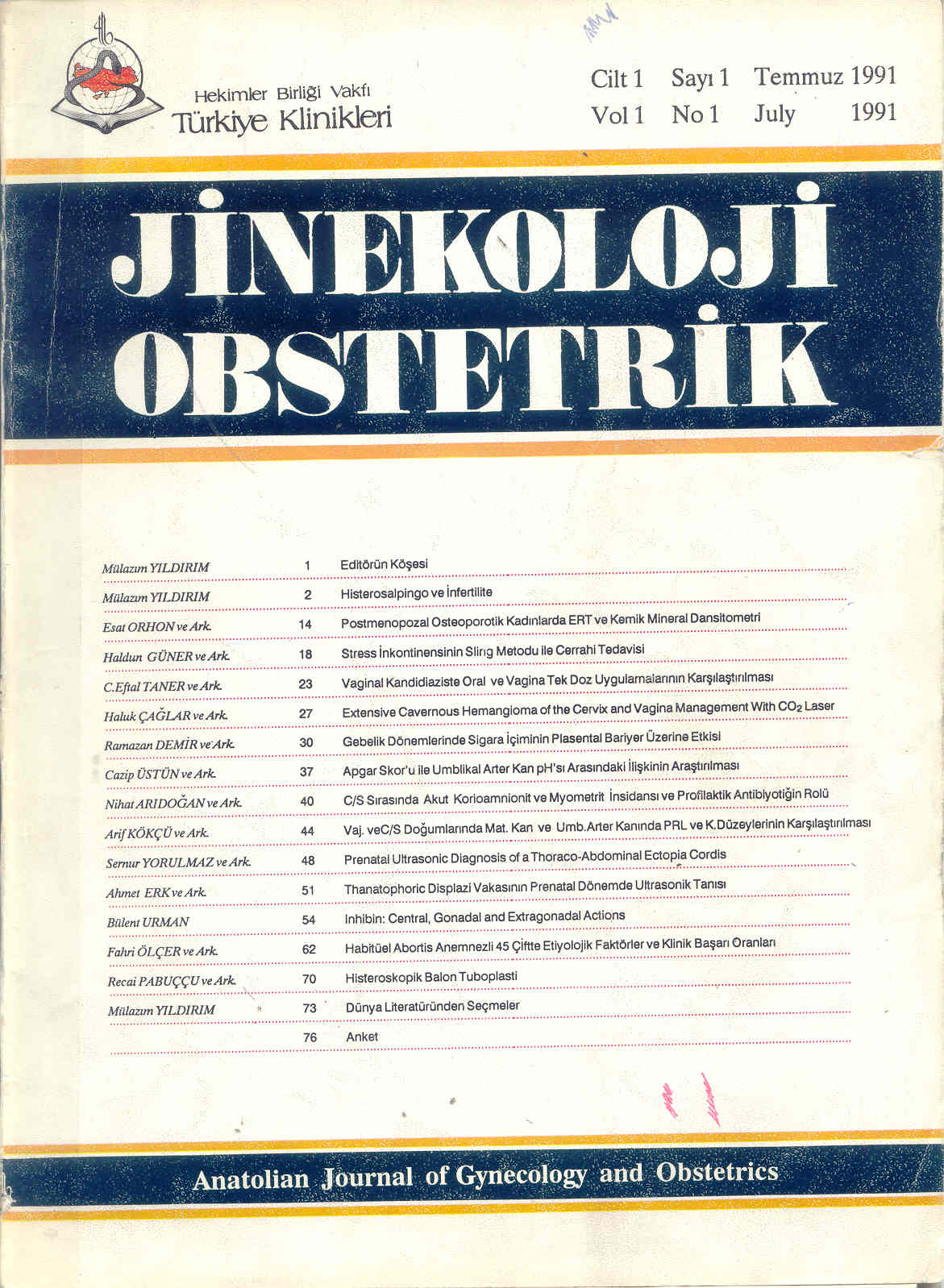Open Access
Peer Reviewed
ARTICLES
3825 Viewed1242 Downloaded
Etiological Factors And Clinical Success Rates In Management Of 45 Couples With A Prior History Of Recurrent Abortion
Habitüel Abortus Anamnezli 45 Çiftte Saptanan Etiyolojik Faktörler ve Elde Edilen Klinik Başarı Oranları
Turkiye Klinikleri J Gynecol Obst. 1991;1(1):62-9
Article Language: TR
Copyright Ⓒ 2025 by Türkiye Klinikleri. This is an open access article under the CC BY-NC-ND license (http://creativecommons.org/licenses/by-nc-nd/4.0/)
ÖZET
Ardışık iki veya daha fazla spontan ya da missed abortus tanımlayan kırkbeş olgu çalışma kapsamına alındı. Olguların %62.2'si primer (n=29), %37.8'i sekonder (n=17) habitüel abortus olarak sınıflandırıldı. Gruplar arasında ortalama yaş ve akraba evliliği açısından farklılık gözlenmedi. Olguların %28.9'unda anatomik, %17.7'sinde immünolojik faktör belirlendi; yaklaşık yarısında ise (n=22) herhangi bir etiyolojik neden saptanmadı. Olguların %44'üne nedene yönelik tedavi uygulandı; geriye kalanlar spontan seyre bırakıldı. Yirminci hafta üzerinde sorunsuz izlenen gebelikler dikkate alındığında, klinik başarı oranının tedavi edilen grupta %82.3, spontan seyre bırakılanlarda %73.3 olduğu belirlendi (p>05); canlı doğumlar göz önüne alındığında ise klinik başarı oranının sırasıyla %82.3 ve %53.3 olduğu saptandı (p>05). Akraba evliliği varlığının habitüel abortus olgularında klinik başarı oranını etkilemediği kaydedildi. Canlı doğum oranının primer grupta %75, sekonder grupta ise %66.7 olduğu belirlendi (p>05). Habitüel abortusun primer veya sekonder olmasının, akraba evliliği varlığının, anamnezdeki abortus tipi ve sayısının ve etiyolojik faktörün klinik başarı oranlarını önemli ölçüde etkilemediği sonucuna varıldı.
Ardışık iki veya daha fazla spontan ya da missed abortus tanımlayan kırkbeş olgu çalışma kapsamına alındı. Olguların %62.2'si primer (n=29), %37.8'i sekonder (n=17) habitüel abortus olarak sınıflandırıldı. Gruplar arasında ortalama yaş ve akraba evliliği açısından farklılık gözlenmedi. Olguların %28.9'unda anatomik, %17.7'sinde immünolojik faktör belirlendi; yaklaşık yarısında ise (n=22) herhangi bir etiyolojik neden saptanmadı. Olguların %44'üne nedene yönelik tedavi uygulandı; geriye kalanlar spontan seyre bırakıldı. Yirminci hafta üzerinde sorunsuz izlenen gebelikler dikkate alındığında, klinik başarı oranının tedavi edilen grupta %82.3, spontan seyre bırakılanlarda %73.3 olduğu belirlendi (p>05); canlı doğumlar göz önüne alındığında ise klinik başarı oranının sırasıyla %82.3 ve %53.3 olduğu saptandı (p>05). Akraba evliliği varlığının habitüel abortus olgularında klinik başarı oranını etkilemediği kaydedildi. Canlı doğum oranının primer grupta %75, sekonder grupta ise %66.7 olduğu belirlendi (p>05). Habitüel abortusun primer veya sekonder olmasının, akraba evliliği varlığının, anamnezdeki abortus tipi ve sayısının ve etiyolojik faktörün klinik başarı oranlarını önemli ölçüde etkilemediği sonucuna varıldı.
ANAHTAR KELİMELER: Habitüel abortus
ABSTRACT
Fourty-five cases of recurrent abortion who described two or more consecutive spontaneous or missed abortion were included in the study group. 62.2% of cases were primary aborter and 37.8% of them were secondary. The groups were comparable in terms of mean age and ratio of consanguineous marriages. In 28.9% of the cases an anatomical factor and in 17.7% an immunological factor were determined. In the remaining half of the cases (n=22) no etiological factor were found. 44% of the cases were treated according to the etiological factor determined and the others were followed without any spesific intervention. When the clinical success rate was taken as the normally ongoing pregnancies over the twentieth weeks of gestation, it was found to be 82.3% in the treated group and 73.3% in the untreated group (p>05). The presence of consanguineous marriage were found not to effect the clinical success rate in recurrent abortions. Livebirths were acquired in 75% of the primary and 66.7% of the secondary habitual abortus cases (p>05). It was concluded that the clinical success rates obtained in habitual aborters did not change with the etiological factor, the type and number of the abortions in the history, the precence of consanguineous marriage and whether the case was primary or secondary.
Fourty-five cases of recurrent abortion who described two or more consecutive spontaneous or missed abortion were included in the study group. 62.2% of cases were primary aborter and 37.8% of them were secondary. The groups were comparable in terms of mean age and ratio of consanguineous marriages. In 28.9% of the cases an anatomical factor and in 17.7% an immunological factor were determined. In the remaining half of the cases (n=22) no etiological factor were found. 44% of the cases were treated according to the etiological factor determined and the others were followed without any spesific intervention. When the clinical success rate was taken as the normally ongoing pregnancies over the twentieth weeks of gestation, it was found to be 82.3% in the treated group and 73.3% in the untreated group (p>05). The presence of consanguineous marriage were found not to effect the clinical success rate in recurrent abortions. Livebirths were acquired in 75% of the primary and 66.7% of the secondary habitual abortus cases (p>05). It was concluded that the clinical success rates obtained in habitual aborters did not change with the etiological factor, the type and number of the abortions in the history, the precence of consanguineous marriage and whether the case was primary or secondary.
MENU
POPULAR ARTICLES
MOST DOWNLOADED ARTICLES





This journal is licensed under a Creative Commons Attribution-NonCommercial-NoDerivatives 4.0 International License.










